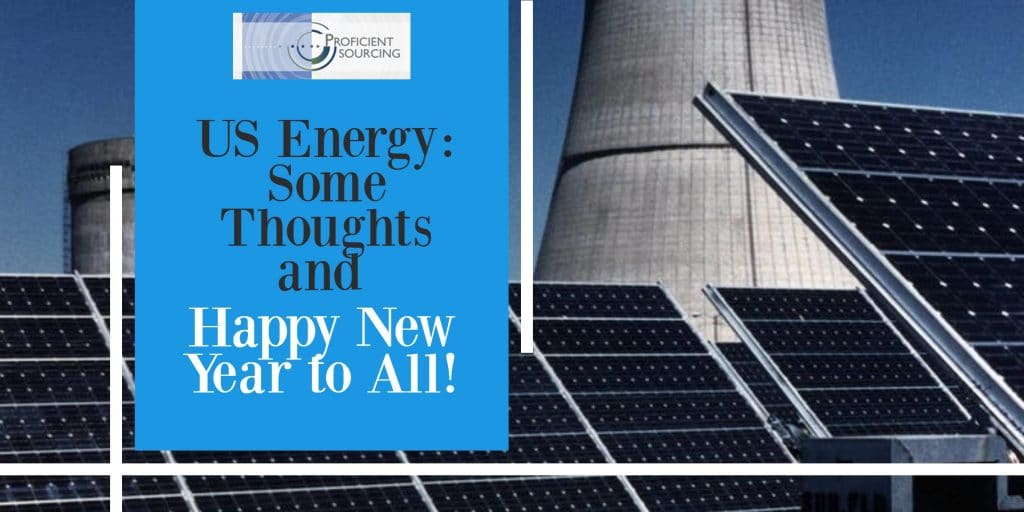
For our first Newsletter effort of 2020 let’s start with a subject of great significance — US energy. Since one of the major advantages of US manufacturing is cheap and abundant energy, it’s an especially important subject for those of us relying on machinery. While we claim no special expertise, we believe there are several important issues to keep in mind as we move forward, and we welcome corrections/comments to our blog.
President Trump reported the US is now energy independent and no longer needs to rely on middle eastern oil. We know the fracking revolution has bumped up US production and Anwar plus the XL pipeline will continue US petroleum energy growth. Is this good news? Some do not think so. But if we truly do not need middle eastern oil, that could be a game changer and an important price stabilizer wouldn’t you think?
At least one current presidential candidate wants to end fracking on day one. The Green New Deal wants to end the use of fossil fuels within a decade or so. Nuclear energy has had a troubled past, and giveaways to companies such as Solyndra have tarnished solar to some extent. And then there’s the overall concern about climate change, and how that relates to energy sources. All these could have major impacts on our energy costs and availability.
Energy sources are measured in different units, which makes any comparison difficult. Here’s a “magic translator” from the US Energy Information Administration:
“Energy sources are measured in different physical units: liquid fuels in barrels or gallons, natural gas in cubic feet, coal in short tons, and electricity in kilowatts and kilowatt-hours. In the United States, British thermal units, BTU’s, a measure of heat energy, is the measure commonly used for comparing different types of energy to each other. In 2018, total U.S. primary energy consumption was equal to about 101,251,057,000,000,000 British thermal units (Btu), or about 101.3 quadrillion Btu”, or 101.3 “Quads”..
Of this total, 36% is petroleum, 31% natural gas, 13% coal, 8% nuclear, and 11% renewables.
Just a few thoughts from a great number of possibilities. The data are mostly from the Energy Information Administration, which contains a vast quantity of energy information.
The US is now the world’s #1 natural gas producer. Annual production is 687 billion cubic meters, which is about 20% of the world’s total. 1 cubic meter is 35.5 cubic feet, and there are 1015 BTU’s per cubic foot. Natural gas is about 35% of our electricity generation. Coal is 28%, Nuclear (and there are 99 nuclear plants) 19%, and renewables 17%.
Why does it take approximately 13 years to design and construct a nuclear plant? If you wrap an aircraft carrier around the reactor, it only takes about 3 years to complete. Does this make any sense? Maybe that’s one reason the cost of nuclear power is so high? A major city with a population of 1 million needs power generation of about 3500 KW, or what a large nuke puts out. There is the issue of waste, but if something as simple as regulatory changes cut into the time and cost of building nuclear power plants, wouldn’t nuclear power make sense for environmental reasons?
Transportation uses about 28% of our total energy, and about 90+% is gasoline/diesel fuel, obviously oil derived. 70% of US oil is consumed in transportation, and currently, there is no reasonable alternative to gasoline/diesel. If fossil fuels are eliminated, or even seriously curtailed, what happens to transportation? Is there any real replacement on the horizon for the approximately 111,000 gas stations in the US? And what about air travel?
Currently, it takes 100 square feet of area for every KW of solar panels; a 1 MW solar power facility would require about 4 acres, which includes space for required accessories. A US city of 1 million requires about 1500 MW of power generation, or that of a large nuclear power plant. An equivalent solar plant would need 6000 acres, or some 9.3 square miles if our math is correct. Also, solar panels are apparently less than 20% efficient. Why can’t efficiency be significantly increased?
The point of all this is that energy is an enormously important and complex subject. We hear statements by politicians that seem to sound good about US energy, but lead to very many more questions. Too bad no one seems to want to provide answers! Since energy is critical to manufacturing success, we are very interested in the subject and would welcome your comments and corrections in our blog.

